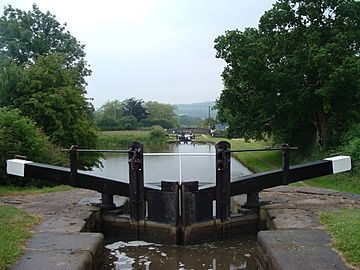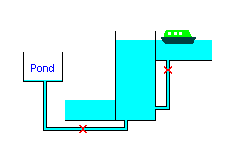Bosley Lock Flight facts for kids

Bosley lock 4, with the top mitre gates of lock 5 in the distance.
|
|
| Waterway | Macclesfield Canal |
|---|---|
| County | Cheshire |
| Maintained by | British Waterways |
| Operation | Manual |
| First built | 1831 |
| Length | 70 feet (21.3 m) |
| Width | 7 feet (2.1 m) |
| Fall | 118 feet (36 m) |
| Above sea level | top lock: 518 feet (158 m) |
| Flight of 12 locks | |
The Bosley Lock Flight is a series of twelve canal locks. You can find them on the Macclesfield Canal in Bosley, near Macclesfield, Cheshire, England. These locks are very strong, built with large stone blocks.
What's special about them? Unlike many narrow locks, they have "mitre gates" at both ends. These gates meet in a V-shape. Each lock also had a "side pond." This pond helped save water when boats moved through the locks. The side ponds haven't been used for many years. However, there are plans to fix one up to show how it worked.
History of Bosley Locks
Building the Macclesfield Canal
The idea for the Macclesfield Canal became law in April 1826. This happened after a special rule called an Act of Parliament was passed. A famous engineer named Thomas Telford helped plan the canal. He thought it would cost about £295,000 to build.
Telford chose the builders for the project. But then, William Crosley, the local engineer, took over. He made sure the building work was excellent. The canal opened on November 9, 1831. It cost a bit more than planned, around £320,000.
How the Canal Was Designed
Like many of Telford's designs, the canal used clever methods. It had "cuttings" (digging through hills) and "embankments" (raised banks). This kept the canal as straight and flat as possible. Because of this, all the locks could be built together in one long flight.
There was also a "stop lock" where the canal met the Hall Green Branch of the Trent and Mersey Canal. The company that built the locks was called Nowell and Sons.
Changes Over Time
When the canal first opened, there was another stop lock. This was at Marple Junction, where it joined the Peak Forest Canal. But this stop lock is no longer there. You can only see a narrow section and old parts of its frame.
Two lock keepers used to manage the Bosley locks. One lived in a cottage near lock 1 at the top. The other lived near lock 11. The top cottage is still standing today. The bottom one, however, has been taken down.
The large stone blocks for the locks came from a nearby quarry. This quarry was close to the bottom of the lock flight. People think a small railway, called a tramway, carried the blocks. In the 1950s, the old quarry became a reservoir.
Exploring the Route
Canal's Journey and Locks
The canal starts near Buglawton, which is on the edge of Congleton. It follows the south side of the River Dane for about 2 miles (3.2 km). Then, it crosses the river on a special bridge called an aqueduct. After that, it climbs up the side of the valley.
The twelve locks are spread out over just 1 mile (1.6 km). They raise the canal's level by 118 feet (36 m). This brings the canal to a height of 518 feet (158 m) above sea level. From there, it stays at this height all the way to Marple Junction. The locks are numbered 1 to 12, starting from the top.
Bridges and Surroundings
Several bridges cross the canal along the lock flight. Daintrys Road Bridge is just below lock 1. The A54 road crosses at Peckerpool Bridge, below lock 5. Swindalls Bridge is a footpath bridge below lock 8. An old railway line used to cross above lock 12.
The area around the locks is mostly countryside and woods. There are quiet places to moor boats, especially for "narrow boats." These boats can be up to 70 feet (21.3 m) long and 7 feet (2.1 m) wide.
Old Railway and Water Supply
The old railway bridge was part of the Churnet Valley Line. This line connected to the main railway from Stoke to Manchester. Bosley railway station was located near lock 5. The railway went through Leek to reach Uttoxeter. Part of this old line is now a special heritage railway.
Because the locks are close together, the sections of canal between them are wider. These wider sections are called "pounds." They hold more water. This helps to keep the water level steady when boats use the locks.
Lock Construction Details
The locks are built from rough, reddish stone called gritstone. Most of them are "grade II listed" structures. This means they are important historical buildings. The listing also includes the side ponds next to each lock.
Daintrys Road Bridge and Peckerpool Wood Bridge are also made of stone. They have rounded arches and were built when the canal opened. Swindalls Bridge is a farm bridge, also made of gritstone. The aqueduct that carries the canal over the River Dane is 45 feet (13.7 m) high. It has a large arch that is 35 feet (10.7 m) wide.
Bosley Reservoir is the main source of water for the canal. It's about 1 mile (1.6 km) east of the locks. A channel, called a feeder, brings water from the reservoir to the canal just above the top lock.
How Locks Work with Side Ponds
Special Gates and Stone Marks
The locks at Bosley are unusual for narrow canals. They have "mitre gates" at both the top and bottom. Most narrow canals use a different type of top gate. The lock chambers are made from huge stone blocks. You can often see special marks, called "mason's marks," carved into the stones.
These locks were built with side ponds to save water. Even though they are not used for saving water anymore, they still act as overflow channels. You can still see the metal frames for the "paddle gear" at four of the locks.
Understanding Side Ponds
Lock ponds are like extra pools of water. They are kept at a level between the canal above and the canal below. When a lock empties, some water from the lock goes into the pond. The rest flows into the canal below. When the lock fills, water from the pond helps fill the bottom of the lock. Then, the rest of the water comes from the canal above.
By designing the ponds carefully, the Bosley locks could reuse about 40 percent of the water. A tunnel, called a culvert, connected the bottom of each lock to its pond. A special "paddle" controlled the water flow through this tunnel. This paddle had to seal the tunnel tightly. It stopped water from flowing out when the lock was full. It also stopped water from flowing in when the lock was empty.
Future Plans for Side Ponds
British Waterways and the Macclesfield Canal Society hope to fix one of the side ponds. They want to show people how it used to work. It would likely be for demonstrations only, not for everyday use. In 2008, the side pond next to lock 4 was cleaned and checked. The paddle gear was too old to fix. However, enough was left to see that it had a special balance system. The stone walls of the pond were still in good shape. The culverts are currently blocked with bricks. These bricks would need to be removed if the side pond is used again.
Overflow System
Each lock has a stone overflow "weir" on the side where people walk (the towpath). This weir is just above the top gates. A stone culvert runs under the towpath. It carries excess water into the side pond. The side pond also has an overflow weir at its lower end. Another culvert then sends any extra water back into the canal below the lock's bottom gates.


